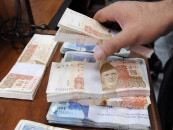Firewall blocks govt's $1tr goal
Plan targets $60b from IT exports which requires unrestricted internet

After being unsatisfied with Stefan Dercon's strategy, Pakistan has finalised a new five-year economic plan to increase the economy's size to $1 trillion. However, some critical goals cannot be achieved until the newly erected social media firewall is dismantled.
The plan also aims to increase the low literacy rate to 70% and reduce poverty incidence by 13% over the next five years. The document has been prepared by the Ministry of Planning and will be formally unveiled by Prime Minister Shehbaz Sharif. The 5Es National Economic Transformation Plan (2024-29) was developed after the UK-based professor Stefan Dercon's "home-grown" economic plan failed to inspire many. However, some in the prime minister's office are lobbying to have both documents launched simultaneously, as significant time and resources were invested in promoting Dercon's plan.
PM Sharif had engaged the UK-based economist to prepare the economic plan. The Pakistan Muslim League-Nawaz (PML-N) government has invested Rs39 billion to erect a social media firewall aimed at minimising the impact of anti-government propaganda. However, this measure has slowed the nation's progress in information technology. Until this firewall is removed, achieving some of the critical goals will remain difficult.
The implementation of the 5Es framework aims to position Pakistan as a $1 trillion economy by 2035. Under a "business as usual" scenario, the economy is projected to remain below $500 billion over the next decade. The plan targets a compound annual growth rate (CAGR) of 9.8% over five years to reach the $1 trillion milestone by 2035.
"In the next 23 years, two nations will turn 100 years old. India knows with certainty where it will be. Do we know where Pakistan will be in 2047?" said Ahsan Iqbal, the Federal Minister for Planning, while speaking to The Express Tribune.
Responding to a question, Iqbal clarified that the 5Es National Economic Transformation Plan is the government's strategic document, while Stefan Dercon's plan is a fiscal strategy. He suggested that both the strategic plan and fiscal strategy could be launched simultaneously.
The National Economic Transformation Plan aims to increase exports related to information technology and freelancing services by $5 billion by 2029a goal that clashes with the current IT policies. IT exports are part of the broader plan to boost overall exports to $60 billion in five years. Achieving this requires a VPN-free, unrestricted social media environment and a shift from a security state to a rule-based democratic society.
Under the goal of E-Pakistan, the plan targets the production of 75,000 IT graduates annually, the expansion of cell phone users to 192 million, and the increase of broadband subscriptions to 135 million. It also includes the creation of over 250 higher education-recognised universities, a 178% increase in IT exports, and the establishment of more than 100 software technology parks. One of the ambitious goals is to have at least one Pakistani unicorn company with a $1 billion market valuation. Currently, no Pakistani company earns $1 billion from exports. In 2023, the highest export value of any company was less than $550 million, achieved in the textile sector.
Daniel Castro, Vice President of the US-based Information Technology and Innovation Foundation, recently observed, "Most leading digital economies focus on expanding digital infrastructure and ensuring connectivity. It's an anomaly to see an advanced digital economy hindering itself by taking people offline." He added, "Internet shutdowns, whether lasting hours or days, impact specific services and impose significant economic costs." By 2029, the plan aims to have 100 million next-generation mobile subscribers, including 10% using 5G technology.
The overarching goal of the plan is non-inflationary, sustainable growth and long-term national prosperity. The plan focuses on exports, a knowledge-based tech economy, environmental and climate change initiatives, energy and infrastructure development, and social empowerment.
The plan promises to cut projected greenhouse gas emissions by 50% and increase the share of renewable energy to 10%. It also aims to reduce poverty incidence by 13% and make Pakistan the world's 10th largest economy by 2047, when the country turns 100. The document outlines Pakistan's challenges, including stagnant growth, declining productivity, outdated industrial practices, an underutilised workforce, and technological lag, all of which limit competitiveness regionally and globally. "Climate change and water scarcity are intensifying food insecurity, putting Pakistan's agriculture sectorand the livelihoods of nearly 40% of the workforceat great risk," the plan states.
The plan will be implemented through the 13th Five-Year Plan, which will serve as a unified blueprint for all ministries and provinces. In the energy sector, the plan aims to increase the share of renewable energy to over 10%, reduce subsidies, and eliminate circular debt to ensure the financial viability of the power sector.
The plan also aims to increase the railway's share of passenger transport from 5% to 15% and freight transport from 8% to 25%. Achieving this requires implementing the $7 billion Mainline-I project under the China-Pakistan Economic Corridor.
The plan promises to create 1.5 million jobs annually and increase universal healthcare coverage by 12%, improving Pakistan's Human Development Index (HDI). The primary education completion rate is targeted to increase to 28%, with secondary education rising to 43%.
The literacy rate is planned to increase by 10% to reach 70% in five years.





















COMMENTS (1)
Comments are moderated and generally will be posted if they are on-topic and not abusive.
For more information, please see our Comments FAQ